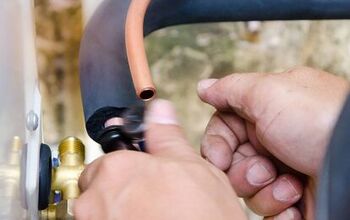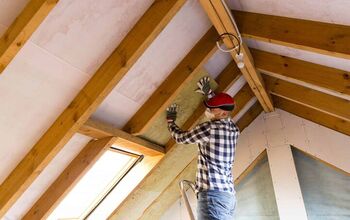How To Drill Into Stucco (Step by Step Guide)

Many people are often nervous to drill into stucco because it looks and feels like concrete. However, it’s relatively simple to do and there are many projects where drilling into stucco is necessary. But, exactly how do you drill into stucco without causing any cracking or damage?
To drill into stucco, use a masonry bit with a carbide or diamond tip slightly smaller than the screw you’re using. Use a hammer drill to make drilling into stucco more manageable and apply firm pressure to the back of the drill. Mark the correct spot to avoid costly mistakes, and for a strong hold, don’t drill farther than ⅛” longer than the screw.
With a 24% share of the siding market of homes, it’s understandable many people would be interested in how to maintain stucco. Without taking the proper steps, stucco can start to break away and become significantly damaged. In this guide, we will explain how you can safely drill into stucco so that it doesn’t break away or crumble.
Do You Need Concrete, Brick, or Stone Pros?
Get free, zero-commitment quotes from pro contractors near you.

What Exactly Is Stucco?
Stucco is a material made of a binding agent, water, and (usually) sand. To use it on walls and ceilings, stucco starts as a paste and then dries into a thick sheathing. Although stucco can be a rigid material, it isn’t used on its own. Instead, stucco is placed on top of other framework to be used as a decorative coating.
Another great benefit of Stucco is that it is relatively easy to repair. Unlike concrete, it is not a significant cause for concern to have chips or cracks in it. It’s cost-effective and fire-resistant. Additionally, it is able to be applied to multiple different types of surfaces. If you’d like to increase the insulation factor of your home, take a look at our comparison between types here.
Steps For How To Drill Into Stucco
You can hang items from your stucco, but it’s essential to do it correctly and carefully. Without the proper steps, stucco can crumble underneath the pressure of a drill.
So, when taking these steps, it is vital that you go at a slower pace and don’t rush the project. Rushing is what allows for mistakes and serious mishaps.
Tools You Need
- Tape measure
- Pencil
- Masonry bit
- Screw
- Anchor
- Hammer drill
If you must drill into the stucco and don’t have a hammer drill, using a standard drill is the next choice. Just be careful with the amount of pressure you use, and be sure to use the correct drill bit.
A standard drill will work just fine on holes 3/8″ or less. However, for larger holes, your best bet is to track down a hammer drill that you can use.
Step One: Prepare To Drill Into Stucco
Find where you want to drill into the stucco using the tape measure and pencil. Decide on which size masonry bit you need to make the correctly sized hole. It’s essential that it is not too big, so the screw going into the hole will hold properly.
Tighten the masonry bit to the hammer drill and line up the bit to the mark. Use both hands to keep the drill steady and stay on your mark.
Step Two: Drill Into The Stucco
With one hand, pull the trigger to turn the drill on. It will automatically start to move forward, drilling into the stucco. While you should push a little to help the drill through the stucco, it’s important not to push too hard.
Keep going forward until there is no resistance – or until you’ve reached the desired depth. Refrain from going further than 1/8 inch longer than the screw to ensure a strong hold.
Step Three: Insert The Screw Into The Stucco
After you’ve turned off the hammer drill, get the dirt and pieces of stucco out of the hole you’ve created. Using compressed air or a baster are good ways of doing this to ensure dust doesn’t blow back into your face.
Finally, you’re ready to put in your screw (and anchor if necessary). If you use an anchor, using a tiny spot of caulk in the hole will hold it the best. Also, make sure to seal the hole’s perimiter after you’re done installing any pipes or other items into the hole.
With these steps, you should know how to drill into stucco with minimal to no damage.
When Not To Drill Into Stucco
When stucco is damaged, it is never a good idea to try to drill through it. Once the material is thoroughly repaired, dried, and checked by a professional, then it should be alright to drill.
You also need to check for electrical wires within the wall you drill. You need to be very careful when drilling into stucco where electrical wires are present. Hitting the wires could cause an expensive issue to deal with, not to mention be potentially dangerous.
Are There Different Types Of Stucco?
There are actually two different types of stucco:
- Synthetic
- Traditional
The traditional stucco consists of cement, water, lime, and sand. This mixture goes over some type of outer framework on the exterior. However, synthetic stucco, on the other hand, is called Exterior Insulation Finishing System (or EIFS). It consists of mesh, foam, synthetic stucco, and some form of top coating in order to seal it.
When comparing the two together, they look incredibly similar and can be hard to distinguish visually. The best way to determine whether a stucco is synthetic or not is to press on it. If it sounds hollow and soft, it is synthetic. Traditional stucco doesn’t sound hollow, nor will it give under a bit of pressure.
Why Should You Use Stucco?
Stucco is an inexpensive option for a home’s exterior. It is a decent insulator and is energy efficient. This explains why it is often a go-to choice for those in the Southwest. Stucco has many different colors added to it for a unique finish and can be easily manipulated for decorative purposes.
This type of material often lasts around 50 years without requiring replacement. Additionally, stucco materials are frequently being updated with newer technology to make them more durable, crack-resistant, and easy to maintain.
Repairing Stucco
Stucco can be damaged in many different ways. An exterior that is crumbling must be replaced with multiple types of materials in order to seal it once more. On the other hand, water damage with stucco can be a bit trickier. The repair process is actually similar.
However, finding and eliminating the source of water that has caused the damage in the first place can be challenging. Only after fixing the water damage should you repair or replace the stucco.
What Are Some Alternatives To Stucco?
There are quite a few alternatives to choose from for those that don’t like the look of stucco. These alternatives include:
- Vinyl
- Veneer
- Brick
- Wood
Vinyl siding is a frequent choice, as there are many varieties and looks to choose from. Vinyl can fit within many budgets as well and is the largest share of the siding industry at 27%.
Veneer is yet another choice that people often choose due to its decorative appearance. It is an extremely durable material with different colors and textures to choose from. Some even mimic a natural stone look.
Bricks are a rather traditional style of siding. Although they can be expensive to install, they often results in a beautiful exterior.
Can You Use Wood In Place Of Stucco?
Like other alternatives, bricks have multiple types of styles to choose from. You can also use wood as a siding alternative. This was a style that had started to die off. More recently, wood siding has come back as an option rising in popularity in country homes. It is an excellent choice for warding off the elements while going for a natural look.
Related Questions
Should I hire someone to fix my stucco, or should I do it myself?
Stucco can be reasonably easy to fix on your own if you have the right tools and experience in it. We recommend only doing a repair if you are confident in your ability to seal it from the elements completely.If using a pro to repair your stucco, expect to pay roughly $60 to $120 per square foot. Or, some professionals charge by the hour, roughly $40 to $50 per hour.
Where can I find stucco?
Stucco isn’t typically a material that comes prepared already. Instead, you would need to buy the ingredients of stucco and mix them to create it. If you are unsure of the proportions for each ingredient, a contractor should be able to help.
Do You Need Concrete, Brick, or Stone Pros?
Get free, zero-commitment quotes from pro contractors near you.

Wrapping It Up
What it ultimately comes down to when drilling stucco is making sure that the stucco is in good condition before you even attempt this. As long as it is, and you have the correct tools, then you can do this pretty easily. However, you will want to take your time so that you avoid shattering or ruining your stucco. Make sure you follow the steps slowly and don’t rush the process, as rushing will likely cause problems.
If you’re not completely confident that you can do this on your own the correct way, then perhaps it would be a good idea to hire a professional. While this can cost quite a bit of money, you’ll ensure you have a job well done. If you don’t want to hire a professional to do the actual drilling, you can at least have your stucco evaluated. If you’re in doubt whether it’s in good enough condition, this is a great idea. That way, you can drill into it with confidence.
Related Guides

We are a team of passionate homeowners, home improvement pros, and DIY enthusiasts who enjoy sharing home improvement, housekeeping, decorating, and more with other homeowners! Whether you're looking for a step-by-step guide on fixing an appliance or the cost of installing a fence, we've here to help.
More by Upgraded Home Team



























